Education Indicators in Canada: An International Perspective 2017
Chapter B
Financial resources invested in education
Archived Content
Information identified as archived is provided for reference, research or recordkeeping purposes. It is not subject to the Government of Canada Web Standards and has not been altered or updated since it was archived. Please "contact us" to request a format other than those available.
B1 Expenditure per student
Context
This indicator provides information on the investment, from all sources, in each student in public and private institutions at several levels of education. Expenditure by educational institutions per student is largely influenced by teachers’ salaries (see Indicators B3 and D2), pension systems, teaching and instructional hours (see Indicator D1), the cost of teaching materials and facilities, the program provided (e.g., general or vocational), and the number of students enrolled in the education system. Policies to attract new teachers or to reduce average class size or change staffing patterns have also contributed to changes in expenditure by educational institutions per student over time. Ancillary and R&D services can also influence the level of expenditure by educational institutions per student.
Effective schools require the right combination of trained and talented personnel, appropriate curriculum, adequate facilities and motivated students who are ready to learn. The demand for high quality education, which can translate into higher costs per student, must be balanced against other demands on public expenditure and the overall burden of taxation. Although it is difficult to assess the optimal volume of resources needed to prepare each student for life and work in modern societies, international comparisons of spending by educational institutions per student can provide useful reference points.
Policy-makers must also balance the importance of improving the quality of educational services with the desirability of expanding access to educational opportunities, notably at the tertiary level. In addition, decisions regarding the allocation of funds among the various levels of education are key. For example, certain provinces and territories emphasize broad access to higher education and some invest in near universal education for children as young as 3 or 4 years of age.
The indicator shows direct public and private expenditure by educational institutionsNote 1 in relation to the number of full-time equivalent students enrolled. Note that variations in expenditure by educational institutions per student may reflect not only variations in the resources provided to students (e.g., variations in the ratio of students to teaching staff) but also variations in relative salary and price levelsNote 2.
Observations
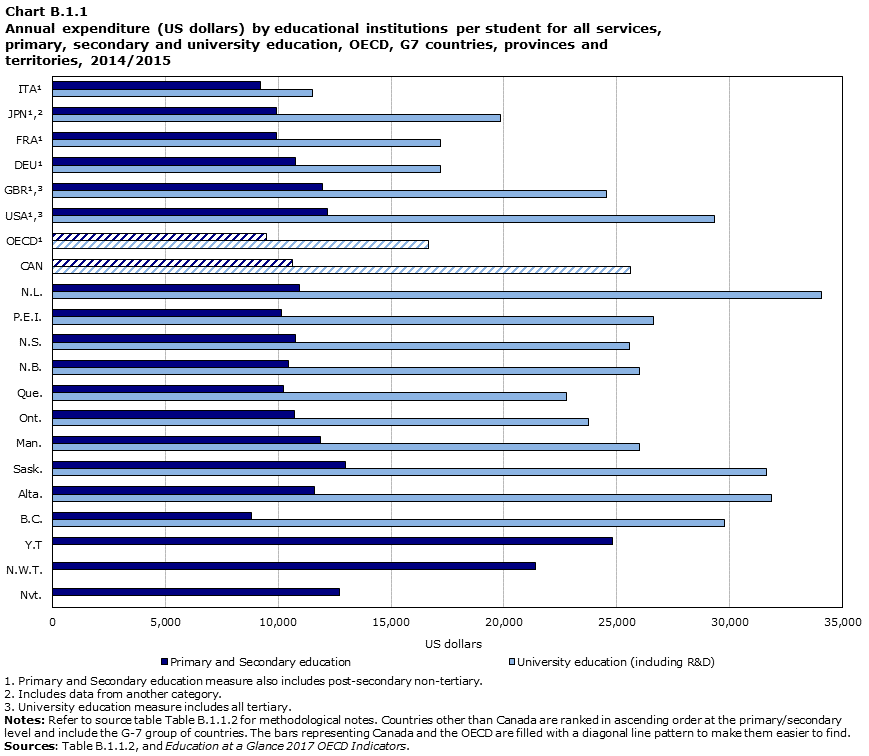
Data table for Chart B.1.1
| Primary and Secondary education | University education (including R&D) | |
|---|---|---|
| US dollars | ||
| ITAData table Note 1 | 9,195 | 11,527 |
| JPNData table Note 1 Data table Note 2 | 9,934 | 19,836 |
| FRAData table Note 1 | 9,944 | 17,178 |
| DEUData table Note 1 | 10,776 | 17,181 |
| GBRData table Note 1 Data table Note 3 | 11,970 | 24,542 |
| USAData table Note 1 Data table Note 3 | 12,176 | 29,328 |
| OECDData table Note 1 | 9,489 | 16,674 |
| CAN | 10,651 | 25,601 |
| N.L. | 10,928 | 34,065 |
| P.E.I. | 10,163 | 26,616 |
| N.S. | 10,775 | 25,580 |
| N.B. | 10,456 | 26,014 |
| Que. | 10,221 | 22,784 |
| Ont. | 10,706 | 23,744 |
| Man. | 11,870 | 26,022 |
| Sask. | 12,982 | 31,625 |
| Alta. | 11,596 | 31,862 |
| B.C. | 8,838 | 29,761 |
| Y.T | 24,824 | Note ...: not applicable |
| N.W.T. | 21,414 | Note ...: not applicable |
| Nvt. | 12,720 | Note ...: not applicable |
... not applicable
Sources: Table B.1.1.2, and Education at a Glance 2017 OECD Indicators. |
||
- Expenditure per student at the primary/secondary level was similar for Canada, the provinces, other G7 countries and the OECD average. In the territories, the structural costs associated with delivering education at the primary and secondary level tend to be higher than those in the provinces.
- In Canada expenditure per student at the university level was higher in all provinces than expenditure per student at the primary/secondary level.
- At $US 25,601, Canada’s figure was almost 55% higher than the OECD average of $US 16,674, but was similar to the averages from the United Kingdom and United States.
- For primary/secondary levels, educational core services represented the bulk of expenditure per student in Canada, across provinces and territories, ranging from 94% for the Newfoundland and Labrador, Nova Scotia, and Quebec, to 99% in Yukon. The corresponding OECD averageNote 3 was similar at 94% of total expenditures on core education. (See Table B.1.2.2)
Definitions, sources and methodology
Data refer to the 2014/2015 financial year and are for the elementary and secondary levels and for the university sector. A method is being developed to estimate this indicator for college as well. The OECD figures are from the UOE data collection on education statistics, administered by the OECD in 2016Note 4.
Expenditure by educational institutions per student at a particular level of education is calculated by dividing the total expenditure by educational institutions at that level by the corresponding full-time equivalent enrolment. Only educational institutions and programs for which both enrolment and expenditure data are available are taken into account. In accordance with the OECD definition provided in the data collection manual, debt servicing expenditure is excluded.
Financial data for elementary and secondary school levels are based on five Statistics Canada surveys: the Survey of Uniform Financial System – School Boards (this is the largest source of expenditure reporting); the Elementary-Secondary Education Survey (ESES); the Survey of Federal Government Expenditures in Support of Education (most of which is for the education of First Nations students); the Survey of Financial Statistics of Private Elementary and Secondary Schools; and the Provincial Expenditures on Education in Reform and Correctional Institutions survey. The last two are inactive, but the figures are estimated based on data from previous years.
Enrolment data for elementary and secondary school levels are the sum of enrolment in public and private schools (ESES) and enrolment in First Nations band-operated schools (Indigenous and Northern Affairs Canada). Enrolment corresponding to the 2014/2015 financial year was obtained using 5/12 of the enrolment for the 2013/2014 school year and 7/12 of the enrolment for the 2014/2015 school year.
In Quebec, vocational training and general education for adults are included at the secondary level. Given that a significant number of these enrolments are part time, the headcounts were adjusted to full-time equivalent enrolments using a ratio last calculated in the 2009/2010 school year. Saskatchewan and British Columbia also report some general education for adults at the secondary level, but the headcount was deemed to be so close to the full-time equivalent value, that unadjusted headcount was used for this indicator. Data for enrolments in British Columbia elementary and secondary schools were revised as of the 2014/2015 data year, thus, this year’s estimate of expenditure per student is not comparable with estimates from previous years.
For the university sector, the financial data were drawn from the Financial Information of Universities and Colleges Survey (FIUC), done in conjunction with the Canadian Association of University Business Officers (CAUBO), and the Survey of Federal Government Expenditures in Support of Education. The enrolment figures come from the Postsecondary Student Information System (PSIS); figures for the 2013/2014 and 2014/2015 academic years were used. Enrolment was first converted into full-time equivalents (i.e., the number of part-time students was divided by 3.5). Then the two academic years were weighted to correspond to the 2014/2015 financial year (April 2014 to March 2015) by applying 5/12 of the first and 7/12 of the second.
In addition, for the university sector, financial data are collected at an institutional level only, and cannot be divided by type of program. As a result, expenditures also include any expenditure for programs that are not at the Bachelor’s, Master’s, or Doctoral levels such as career, technical or professional training programs. In order to be consistent, enrolment for these additional programs have also been retained in the analysis.
For comparison with the OECD, expenditure in Canadian currency was converted into equivalent US dollars by dividing the national currency figure by the purchasing power parity (PPP) index for the gross domestic product (GDP). The value of 1.24 (for the calendar year 2014) was used. The PPP index was used because the market exchange rate is affected by many factors (interest rates, trade policies, economic growth forecasts, etc.) that have little to do with current relative domestic purchasing power in different OECD countries. Expenditure data are not adjusted for the differences in the cost of living across the provinces and territories.
Educational core services are the expenditure portion that covers the real mission of educational institutions, which is to provide education. There are also expenditures on ancillary services, which have two main components: student welfare services (transportation, lodging and meals) and services for the general public (museums, radio and cultural programs). In the university sector, ancillary services typically include bookstores, food services (dining hall, cafeterias and vending machines), residences and housing, parking, university press publishing, laundry services, property rentals, university facility rentals, theaters, and conference centers.
Education expenditure at the tertiary level also includes expenditure on research and development, such as subsidies received by the institution for research projects and an estimate of the proportion of other current expenditures allocated to research and development.
The OECD average is calculated as the average of all OECD countries for which data are available.
Note: The corresponding OECD indicator is B1, How much is spent per student?.
Tables for B1 Expenditure per student
B2 Expenditure on education as a percentage of GDP
Context
This indicator provides a measure of the proportion of national wealth that is invested in educational institutions by linking public and private expenditures with gross domestic product (GDP).
Expenditure on education is an investment that can help foster economic growth and enhance productivity. Education contributes to personal and social development and reduces social inequality. The allocation of financial resources to educational institutions is a collective choice, made by government, business, and individual students and their families. It is partially influenced by the size of the school-age population and enrolment in education, as well as relative wealth.
Observations
GDP allocated to educational institutions
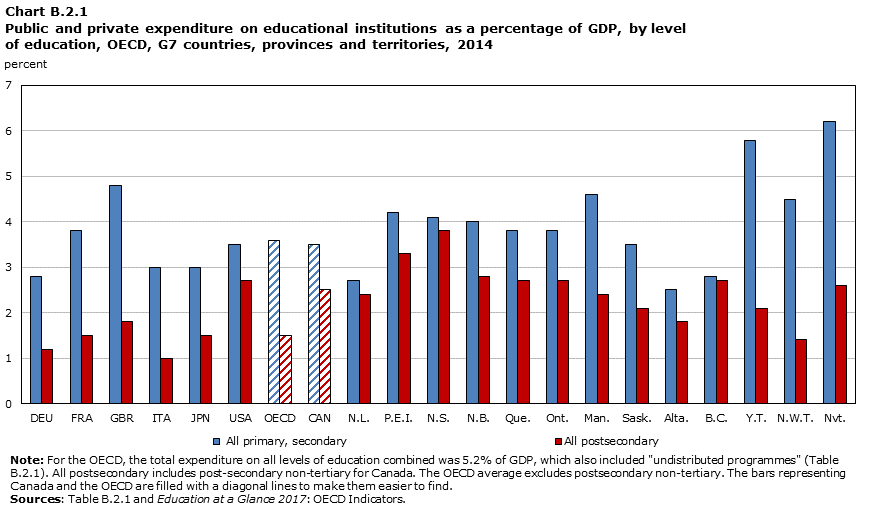
Data table for Chart B.2.1
| All primary, secondary | All postsecondary | |
|---|---|---|
| percent | ||
| DEU | 2.8 | 1.2 |
| FRA | 3.8 | 1.5 |
| GBR | 4.8 | 1.8 |
| ITA | 3.0 | 1.0 |
| JPN | 3.0 | 1.5 |
| USA | 3.5 | 2.7 |
| OECD | 3.6 | 1.5 |
| CAN | 3.5 | 2.5 |
| N.L. | 2.7 | 2.4 |
| P.E.I. | 4.2 | 3.3 |
| N.S. | 4.1 | 3.8 |
| N.B. | 4.0 | 2.8 |
| Que. | 3.8 | 2.7 |
| Ont. | 3.8 | 2.7 |
| Man. | 4.6 | 2.4 |
| Sask. | 3.5 | 2.1 |
| Alta. | 2.5 | 1.8 |
| B.C. | 2.8 | 2.7 |
| Y.T. | 5.8 | 2.1 |
| N.W.T. | 4.5 | 1.4 |
| Nvt. | 6.2 | 2.6 |
|
Note: For the OECD, the total expenditure on all levels of education combined was 5.2% of GDP, which also included "undistributed programmes" (Table B.2.1). All postsecondary includes post-secondary non-tertiary for Canada. The OECD average excludes postsecondary non-tertiary. The bars representing Canada and the OECD are filled with a diagonal line pattern to make them easier to find. Source: Table B.2.1 and Education at a Glance 2017: OECD Indicators. |
||
- With 6.0% of its GDP allocated to educational institutions in 2014 (3.5% for primary and secondary education plus 2.5% for all postsecondary education), Canada devoted more than the 5.2% average estimated by the OECD average (3.6% and 1.5% respectively).
- In 2014, the financial commitment to educational institutions varied from one province or territory to another, ranging from 4.3% of GDP in AlbertaNote 5 to 8.8% in NunavutNote 6.
- Within the G7 countries, the range was from 4.0% in Italy to 6.6% in the United Kingdom.
Share of wealth invested in primary and secondary versus tertiary education
- In all G7 countries, Canada included, and at the OECD average, the share of national wealth invested in education was larger for primary and secondary education than that for tertiary education in 2014.
- In comparison with the OECD average and most G7 countries with the exception of the United States, Canada’s share of national wealth spent on education was smaller for primary and secondary education and larger for tertiary education.
Definitions, sources and methodology
This indicator shows expenditure (public and private) with regard to educational institutions as a percentage of gross domestic product (GDP), by level of education and for all levels of education combined.
“Expenditure on educational institutions” includes spending on both instructional and non-instructional educational institutions. Instructional educational institutions are entities that provide instructional programmes (e.g., teaching) to individuals directly in an organized group setting or through distance education.Note 7 Non-instructional educational institutions are entities that provide advisory, administrative or professional services to other educational institutions but do not enrol students themselves.
Canada classifies expenditure by education level in a way that differs slightly from that of most other countries; that is, expenditure on pre-elementary education is grouped with expenditure at the elementary and secondary levels, while expenditure on postsecondary non-tertiary education (essentially technical and vocational training) is grouped with tertiary-type B expenditure. This should not affect international comparability, however, since expenditure at the elementary and secondary levels is dominant.
The financial data for Canada were drawn from seven Statistics Canada surveysNote 8 and exclude expenditure related to debt service. GDP data were provided by the System of National Accounts Branch. All data for Canada, the provinces and territories refer to the 2014 financial year. The OECD averages (for the 2014 financial year) are based on data from all countries collected by the OECD through the UOE data collection on educational systems, conducted jointly by three international organizations (UNESCO, the OECD and Eurostat) and administered by the OECD in 2016.
Note: The corresponding OECD indicator is B2, What proportion of national wealth is spent on education?.
Tables for B2 Expenditure on education as a percentage of GDP
B3 Distribution of expenditure on education
Context
This indicator outlines spending on education services and resources, identifying the proportion of budgets allocated to currentNote 9 and capitalNote 10 expenditures. A breakdown of current spending—compensation of teachers, other staff and other expenses—is also presented.
The distribution of expenditures may be influenced by a number of factors, including compensation for teachers, the generosity of pension plans, the size of the non-teaching staff, and the different needs for infrastructure. Budget allocation can affect the quality of services, the condition of equipment, and the ability of the education system to adapt to changes in enrolments. Both budgetary and structural decisions taken at the system level have repercussions extending into the classroom: they influence the nature of instruction and the conditions in which it is provided.Observations
Current and capital expenditures
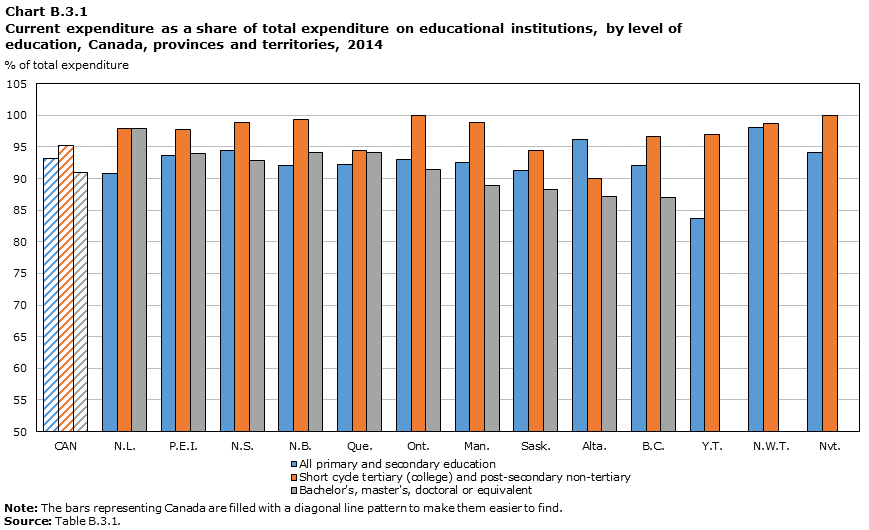
Data table for Chart B.3.1
| All primary and secondary education | Short cycle tertiary (college) and post-secondary non-tertiary | Bachelor's, master's, doctoral or equivalent | |
|---|---|---|---|
| % of total expenditure | |||
| CAN | 93.1 | 95.2 | 90.9 |
| N.L. | 90.8 | 97.9 | 97.9 |
| P.E.I. | 93.6 | 97.7 | 94.0 |
| N.S. | 94.4 | 98.9 | 92.9 |
| N.B. | 92.0 | 99.3 | 94.1 |
| Que. | 92.2 | 94.4 | 94.2 |
| Ont. | 93.0 | 99.9 | 91.4 |
| Man. | 92.6 | 98.8 | 88.9 |
| Sask. | 91.3 | 94.5 | 88.3 |
| Alta. | 96.2 | 90.0 | 87.2 |
| B.C. | 92.1 | 96.6 | 87.0 |
| Y.T. | 83.7 | 97.0 | Note ...: not applicable |
| N.W.T. | 98.1 | 98.7 | Note ...: not applicable |
| Nvt. | 94.1 | 100.0 | Note ...: not applicable |
|
... not applicable Note: The bars representing Canada are filled with a diagonal line pattern to make them easier to find. Source: Table B.3.1. |
|||
- In 2014, the rate of spending on current expenditure exceeded that on capital expenditure at all levels of education for Canada, provinces, territories and in all OECD3 countries. In Canada, current expenditure accounted for 93% of total expenditure at primary and secondary education levels; 95% for short cycle tertiary (college) and post-secondary non-tertiary level, and 91% for bachelor's, master's, doctoral or equivalent.
- Overall, the highest current spending rate was observed at the level of short cycle tertiary (college) and post-secondary non-tertiary. Within the provinces and territories, this rate varied from 90% for Alberta to 100% for Ontario and Nunavut.
- At the postsecondary level,Note 11 capital expenditure was 8% in Canada, compared with 11% for the OECD average.
Compensation of all staff and compensation of teachers
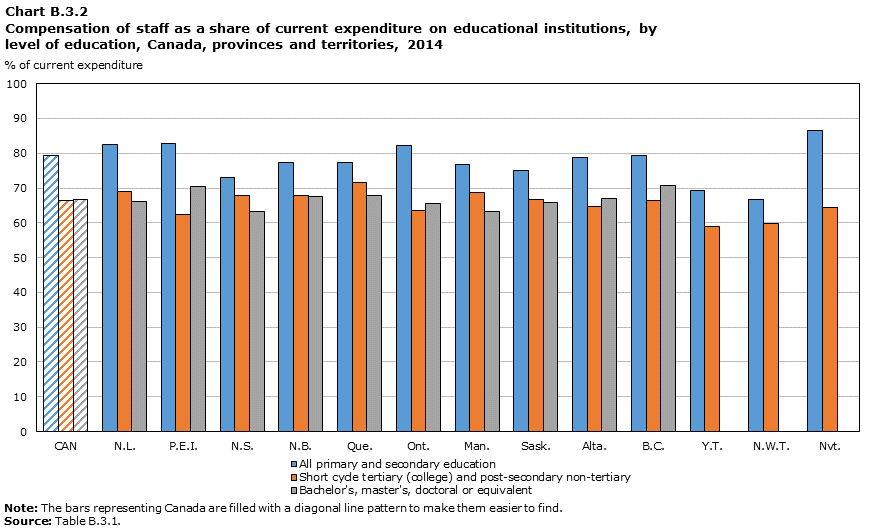
Data table for Chart B.3.2
| All primary and secondary education | Short cycle tertiary (college) and post-secondary non-tertiary | Bachelor's, master's, doctoral or equivalent | |
|---|---|---|---|
| % of current expenditure | |||
| CAN | 79.4 | 66.3 | 66.7 |
| N.L. | 82.4 | 68.9 | 66.2 |
| P.E.I. | 82.9 | 62.4 | 70.5 |
| N.S. | 73.0 | 67.8 | 63.2 |
| N.B. | 77.3 | 68.0 | 67.5 |
| Que. | 77.3 | 71.7 | 67.8 |
| Ont. | 82.1 | 63.5 | 65.5 |
| Man. | 76.8 | 68.8 | 63.4 |
| Sask. | 75.1 | 66.8 | 65.9 |
| Alta. | 78.7 | 64.7 | 67.0 |
| B.C. | 79.5 | 66.4 | 70.7 |
| Y.T. | 69.2 | 59.0 | Note ...: not applicable |
| N.W.T. | 66.6 | 59.7 | Note ...: not applicable |
| Nvt. | 86.6 | 64.3 | Note ...: not applicable |
|
... not applicable Note: The bars representing Canada are filled with a diagonal line pattern to make them easier to find. Source: Table B.3.1. |
|||
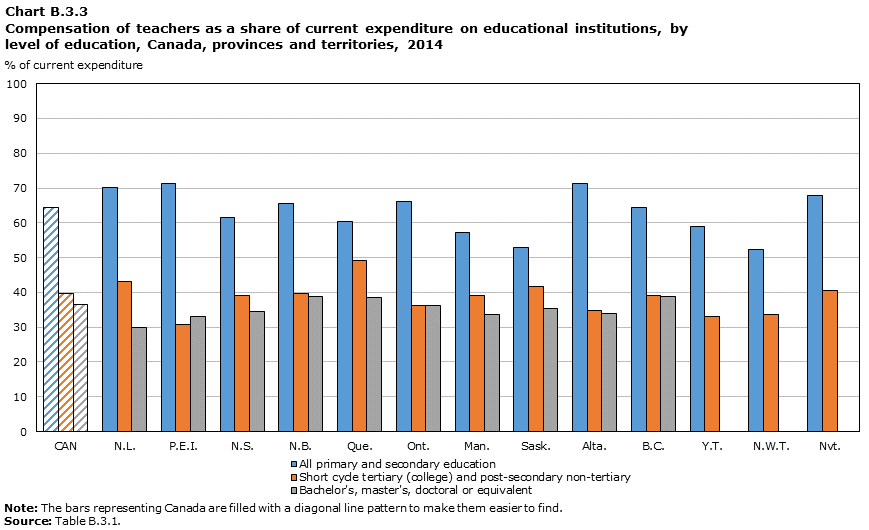
Data table for Chart B.3.3
| All primary and secondary education | Short cycle tertiary (college) and post-secondary non-tertiary | Bachelor's, master's, doctoral or equivalent | |
|---|---|---|---|
| % of current expenditure | |||
| CAN | 64.4 | 39.8 | 36.5 |
| N.L. | 70.2 | 43.2 | 30.0 |
| P.E.I. | 71.4 | 30.8 | 33.2 |
| N.S. | 61.5 | 39.2 | 34.5 |
| N.B. | 65.7 | 39.8 | 38.7 |
| Que. | 60.4 | 49.2 | 38.6 |
| Ont. | 66.1 | 36.3 | 36.2 |
| Man. | 57.1 | 39.1 | 33.6 |
| Sask. | 52.8 | 41.7 | 35.3 |
| Alta. | 71.4 | 34.7 | 33.8 |
| B.C. | 64.5 | 39.2 | 38.7 |
| Y.T. | 58.9 | 33.1 | Note ...: not applicable |
| N.W.T. | 52.4 | 33.7 | Note ...: not applicable |
| Nvt. | 67.9 | 40.5 | Note ...: not applicable |
|
... not applicable Note: The bars representing Canada are filled with a diagonal line pattern to make them easier to find. Source: Table B.3.1. |
|||
- At all levels of education and in all provinces and territories, the compensation of staff (teaching and non-teaching) accounted for the largest proportion of current expenditure on education. In Canada, it represented on average 79% of current expenditure at the primary and secondary levels, 66% at the short cycle tertiary (college) and postsecondary non-tertiary level, and 67% at the university level.
- In all provinces and territories, the proportion of spending related to compensation of staff was highest in primary and secondary education, ranging from 67% in the Northwest Territories to 87% in Nunavut.
- For primary and secondary education, compensation of teachers accounted for the largest proportion of compensation of staff. In Canada, compensation of teachers at these levels represented 64% of current spending in 2014, compared with 15% for compensation of other staff. This difference was less pronounced at the short cycle tertiary (college) and postsecondary non-tertiary level and at the university level.
- Other current expenditure was higher at the postsecondary level than at the primary and secondary levels. For 2014, the Canadian average was 34% for short cycle tertiary (college) and postsecondary non-tertiary education, and 33% for university education, compared with 21% for primary and secondary education. The OECD average for other expenditure at the postsecondary level was 33%, similar to the Canadian average of 34%.
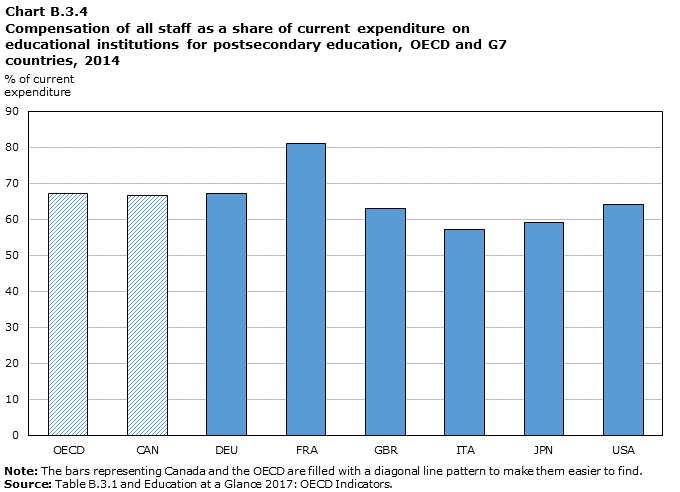
Data table for Chart B.3.4
| Compensation of all staff as a share of current expenditure for postsecondary education | |
|---|---|
| % of current expenditure | |
| OECD | 67.0 |
| CAN | 66.6 |
| DEU | 67.0 |
| FRA | 81.0 |
| GBR | 63.0 |
| ITA | 57.0 |
| JPN | 59.0 |
| USA | 64.0 |
|
Note: The bars representing Canada and the OECD are filled with a diagonal line pattern to make them easier to find. Source: Table B.3.1, Education at a Glance 2017: OECD Indicators. |
|
- For the OECD and G7 averages, as for Canada, compensation of staff (teaching and non-teaching) made up the largest proportion of current expenditure for postsecondary education. Among G7 countries, this expenditure varied from 57% in Italy to 81% in France, whereas the Canadian and OECD averages were 67%.
Definitions, sources and methodology
This indicator shows the proportion of budgets allocated to current and capital spending at different education levels. Expenditures are based on accrual and cash (or fund) accounting, depending on the data source(s) used by the provinces/territories. It also shows the proportion of current expenditure allocated to compensation of teachers and of other staff, along with other current expenditure.
The distinction between current expenditure and capital expenditure is taken from the standard definition used in national accounts. Current refers to resources used each year by institutions as they carry out their activities. It includes research and development expenditures, which are not capital expenditures. Capital covers assets that last longer than one year, including spending on new or replacement equipment and construction or renovation of buildings. Neither takes expenditure related to debt service into account.
Expenditure on educational core services includes all expenditure directly related to instruction and education; i.e., all expenditure on teachers, school buildings, teaching materials, books and administration of schools.
The data for Canada reflect the 2014 financial year, and figures were drawn from seven Statistics Canada surveys: the Elementary-Secondary Education Survey; the Survey of Uniform Financial System-School Boards; the Survey of Financial Statistics of Private Elementary and Secondary Schools; the Financial Information of Universities and Colleges Survey; the Survey of Federal Government Expenditures in Support of Education and Financial Statistics of Community Colleges and Vocational Schools. Information for OECD member countries, and the OECD averages, refer to data for the 2014 financial year and are based on the data collection on educational systems conducted jointly by three international organizations—UNESCO, the OECD and Eurostat—and administered by the OECD.
Note: The corresponding OECD indicator is B6, On what resources and services is education funding spent?.
- Date modified:
